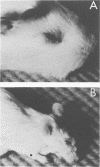Abstract
The virulence of 10 strains of Yersinia enterocolitica containing 42- to 44-megadalton plasmids (serogroups O:3; O:4,32; O:8; O:9; O:13,7; and O:21) was compared in mice and guinea pigs. Adult mice were more responsive than guinea pigs to the Sereny-like conjunctivitis test. In tests on suckling mice, all Yersinia strains harboring plasmids were lethal, whereas all strains without plasmids were nonlethal. All strains of serogroups O:4,32; O:8; O:13,7; or O:21 which harbored a plasmid gave positive results in the mouse Sereny, peroral, and intraperitoneal tests. A positive reaction in these tests was correlated with the ability of the strains to elaborate lipase. Because the Sereny, peroral, and intraperitoneal tests measured the same virulence factor(s), the findings in any of these three tests would accurately predict the results of the other two tests. Mice which survived the Sereny and peroral tests were subsequently challenged intraperitoneally with 1,000 mouse lethal doses of the virulent WA (O:8) strain. Those inoculated with plasmid-harboring strains were protected, whereas those inoculated with plasmid-free strains were not.
Full text
PDF





Images in this article
Selected References
These references are in PubMed. This may not be the complete list of references from this article.
- Aulisio C. C., Mehlman I. J., Sanders A. C. Alkali method for rapid recovery of Yersinia enterocolitica and Yersinia pseudotuberculosis from foods. Appl Environ Microbiol. 1980 Jan;39(1):135–140. doi: 10.1128/aem.39.1.135-140.1980. [DOI] [PMC free article] [PubMed] [Google Scholar]
- Black R. E., Jackson R. J., Tsai T., Medvesky M., Shayegani M., Feeley J. C., MacLeod K. I., Wakelee A. M. Epidemic Yersinia enterocolitica infection due to contaminated chocolate milk. N Engl J Med. 1978 Jan 12;298(2):76–79. doi: 10.1056/NEJM197801122980204. [DOI] [PubMed] [Google Scholar]
- Boyce J. M., Evans E. J., Jr, Evans D. G., DuPont H. L. Production of heat-stable, methanol-soluble enterotoxin by Yersinia enterocolitica. Infect Immun. 1979 Aug;25(2):532–537. doi: 10.1128/iai.25.2.532-537.1979. [DOI] [PMC free article] [PubMed] [Google Scholar]
- Bölin I., Norlander L., Wolf-Watz H. Temperature-inducible outer membrane protein of Yersinia pseudotuberculosis and Yersinia enterocolitica is associated with the virulence plasmid. Infect Immun. 1982 Aug;37(2):506–512. doi: 10.1128/iai.37.2.506-512.1982. [DOI] [PMC free article] [PubMed] [Google Scholar]
- Carter P. B., Collins F. M. Experimental Yersinia enterocolitica infection in mice: kinetics of growth. Infect Immun. 1974 May;9(5):851–857. doi: 10.1128/iai.9.5.851-857.1974. [DOI] [PMC free article] [PubMed] [Google Scholar]
- Dean A. G., Ching Y. C., Williams R. G., Harden L. B. Test for Escherichia coli enterotoxin using infant mice: application in a study of diarrhea in children in Honolulu. J Infect Dis. 1972 Apr;125(4):407–411. doi: 10.1093/infdis/125.4.407. [DOI] [PubMed] [Google Scholar]
- Gemski P., Lazere J. R., Casey T. Plasmid associated with pathogenicity and calcium dependency of Yersinia enterocolitica. Infect Immun. 1980 Feb;27(2):682–685. doi: 10.1128/iai.27.2.682-685.1980. [DOI] [PMC free article] [PubMed] [Google Scholar]
- Kado C. I., Liu S. T. Rapid procedure for detection and isolation of large and small plasmids. J Bacteriol. 1981 Mar;145(3):1365–1373. doi: 10.1128/jb.145.3.1365-1373.1981. [DOI] [PMC free article] [PubMed] [Google Scholar]
- Kay B. A., Wachsmuth K., Gemski P. New virulence-associated plasmid in Yersinia enterocolitica. J Clin Microbiol. 1982 Jun;15(6):1161–1163. doi: 10.1128/jcm.15.6.1161-1163.1982. [DOI] [PMC free article] [PubMed] [Google Scholar]
- Laird W. J., Cavanaugh D. C. Correlation of autoagglutination and virulence of yersiniae. J Clin Microbiol. 1980 Apr;11(4):430–432. doi: 10.1128/jcm.11.4.430-432.1980. [DOI] [PMC free article] [PubMed] [Google Scholar]
- Lee W. H., McGrath P. P., Carter P. H., Eide E. L. The ability of some Yersinia enterocolitica strains to invade HeLa cells. Can J Microbiol. 1977 Dec;23(12):1714–1722. doi: 10.1139/m77-247. [DOI] [PubMed] [Google Scholar]
- Meyers J. A., Sanchez D., Elwell L. P., Falkow S. Simple agarose gel electrophoretic method for the identification and characterization of plasmid deoxyribonucleic acid. J Bacteriol. 1976 Sep;127(3):1529–1537. doi: 10.1128/jb.127.3.1529-1537.1976. [DOI] [PMC free article] [PubMed] [Google Scholar]
- Mors V., Pai C. H. Pathogenic properties of Yersinia enterocolitica. Infect Immun. 1980 Apr;28(1):292–294. doi: 10.1128/iai.28.1.292-294.1980. [DOI] [PMC free article] [PubMed] [Google Scholar]
- Pai C. H., DeStephano L. Serum resistance associated with virulence in Yersinia enterocolitica. Infect Immun. 1982 Feb;35(2):605–611. doi: 10.1128/iai.35.2.605-611.1982. [DOI] [PMC free article] [PubMed] [Google Scholar]
- Pai C. H., Mors V. Production of enterotoxin by Yersinia enterocolitica. Infect Immun. 1978 Mar;19(3):908–911. doi: 10.1128/iai.19.3.908-911.1978. [DOI] [PMC free article] [PubMed] [Google Scholar]
- Pai C. H., Mors V., Seemayer T. A. Experimental Yersinia enterocolitica enteritis in rabbits. Infect Immun. 1980 Apr;28(1):238–244. doi: 10.1128/iai.28.1.238-244.1980. [DOI] [PMC free article] [PubMed] [Google Scholar]
- SERENY B. Experimental shigella keratoconjunctivitis; a preliminary report. Acta Microbiol Acad Sci Hung. 1955;2(3):293–296. [PubMed] [Google Scholar]
- Schiemann D. A. An enterotoxin-negative strain of Yersinia enterocolitica serotype O:3 is capable of producing diarrhea in mice. Infect Immun. 1981 May;32(2):571–574. doi: 10.1128/iai.32.2.571-574.1981. [DOI] [PMC free article] [PubMed] [Google Scholar]
- Schiemann D. A. Development of a two-step enrichment procedure for recovery of Yersinia enterocolitica from food. Appl Environ Microbiol. 1982 Jan;43(1):14–27. doi: 10.1128/aem.43.1.14-27.1982. [DOI] [PMC free article] [PubMed] [Google Scholar]
- Schiemann D. A., Devenish J. A. Relationship of HeLa cell infectivity to biochemical, serological, and virulence characteristics of Yersinia enterocolitica. Infect Immun. 1982 Feb;35(2):497–506. doi: 10.1128/iai.35.2.497-506.1982. [DOI] [PMC free article] [PubMed] [Google Scholar]
- Stieglitz H., Fonseca R., Olarte J., Kupersztoch-Portnoy Y. M. Linkage of heat-stable enterotoxin activity and ampicillin resistance in a plasmid isolated from an Escherichia coli strain of human origin. Infect Immun. 1980 Nov;30(2):617–620. doi: 10.1128/iai.30.2.617-620.1980. [DOI] [PMC free article] [PubMed] [Google Scholar]
- Weissfeld A. S., Sonnenwirth A. C. Rapid isolation of Yersinia spp. from feces. J Clin Microbiol. 1982 Mar;15(3):508–510. doi: 10.1128/jcm.15.3.508-510.1982. [DOI] [PMC free article] [PubMed] [Google Scholar]
- Winblad S., Niléhn B., Sternby N. H. Yersinia enterocolitica (Pasteurella x) in human enteric infections. Br Med J. 1966 Dec 3;2(5526):1363–1366. doi: 10.1136/bmj.2.5526.1363. [DOI] [PMC free article] [PubMed] [Google Scholar]
- Zink D. L., Feeley J. C., Wells J. G., Vanderzant C., Vickery J. C., Roof W. D., O'Donovan G. A. Plasmid-mediated tissue invasiveness in Yersinia enterocolitica. Nature. 1980 Jan 10;283(5743):224–226. doi: 10.1038/283224a0. [DOI] [PubMed] [Google Scholar]




